|
|
|
Sort Order |
|
|
|
Items / Page
|
|
|
|
|
|
|
| Srl | Item |
| 1 |
ID:
179391
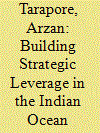

|
|
|
|
|
| Summary/Abstract |
Over the past decade, China has established a permanent and escalating military presence in the Indian Ocean region. The littoral states, islands, and waters of the Indian Ocean—defined here by the choke points of the Cape of Good Hope, Bab el-Mandeb, the Strait of Hormuz, the Malacca Strait, and the Torres Strait—are part of the wider Indo-Pacific region, but they constitute a distinct strategic landscape. The United States’ strategic competition with China does extend to the Indian Ocean region, but it does not take the same form as the heavily militarized territorial disputes of the western rim of the Pacific Ocean or the South China Sea, which attract the lion’s share of attention from US policymakers and military planners. The Indian Ocean faces a particular set of strategic risks and a particular constellation of likeminded partners—an effective strategy must account for those particularities.
|
|
|
|
|
|
|
|
|
|
|
|
|
|
|
|
| 2 |
ID:
179382
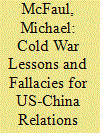

|
|
|
|
|
| Summary/Abstract |
After a 30-year interregnum, the Cold War is back, or at least that’s what many now argue.1 The 2017 Trump administration National Security Strategy portrayed China squarely as a “revisionist” power, alongside Russia, that seeks “to shape a world antithetical to U.S. values and interests.”2 In a series of four carefully coordinated speeches last summer, senior Trump officials cast the Chinese threat in distinctly Cold War terms. National Security Advisor Robert O’Brien described Chinese President Xi Jinping as Josef Stalin’s successor.
|
|
|
|
|
|
|
|
|
|
|
|
|
|
|
|
| 3 |
ID:
179389
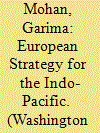

|
|
|
|
|
| Summary/Abstract |
While addressing a group of German diplomats in May 2020, the EU’s High Representative for Foreign Affairs Josep Borrell remarked, “we need a more robust strategy for China, which also requires better relations with the rest of democratic Asia.”1 In September 2020, the German government unexpectedly launched a comprehensive set of guidelines for engaging with the Indo-Pacific and announced that, together with France and the Netherlands, it will push for the EU to adopt a similar strategy. The debate around the Indo-Pacific has been gaining traction across the world, but Europe’s turn toward the region has surprised many—until almost a year ago, most European countries (except for France) were reluctant to even use the term “Indo-Pacific.” It is no coincidence that this recent embrace of the Indo-Pacific has come at a time when Europe-China relations have hit an all-time low.
|
|
|
|
|
|
|
|
|
|
|
|
|
|
|
|
| 4 |
ID:
179388


|
|
|
|
|
| Summary/Abstract |
On September 9, 2020, Frances Adamson, Secretary of the Australian Department of Foreign Affairs and Trade (DFAT); François Delattre, Secretary-General of the French Ministry of Europe and Foreign Affairs; and Vardhan Shringla, India’s Foreign Secretary, held their first trilateral meeting in an effort to strengthen cooperation among the three countries. According to the terms of the joint communiqué, “the trilateral dialogue helped underscore the goal of guaranteeing peace, security and adherence to international law in the Indo-Pacific by drawing on the excellence of bilateral relations between France, India and Australia” and emphasizing their will to “successfully conclude concrete cooperation projects in the maritime sector and those promoting global commons (climate, environment and biodiversity, health).”
|
|
|
|
|
|
|
|
|
|
|
|
|
|
|
|
| 5 |
ID:
179384
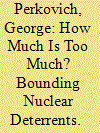

|
|
|
|
|
| Summary/Abstract |
The United States’ nuclear weapons modernization budget is sloping up like a ski jump. It includes down payments to develop two new missiles, a new nuclear warhead, and new generations of bombers and ballistic missile submarines. Russia, with its stockpile of roughly 4,500 nuclear weapons, is developing and/or deploying a new type of intercontinental ballistic missile (ICBM) capable of carrying more than 10 nuclear warheads, a hypersonic glide vehicle, an autonomous underwater torpedo that President Putin claimed could deliver a nuclear weapon to the US coast, and a nuclear-powered cruise missile with unlimited range.
|
|
|
|
|
|
|
|
|
|
|
|
|
|
|
|
| 6 |
ID:
179390


|
|
|
|
|
| Summary/Abstract |
The growing importance of the Indian and Pacific Oceans and the rapidly evolving geopolitical landscape in Asia have brought the Indo-Pacific construct to the center of global political discourse. The region is marked by uncertainty about expansionist Chinese territorial policies and concerns about the United States’ long-term commitment to Asia amidst inherent limitations of existing regional multilateral institutions. This geography is being viewed as the new and expanded theater of great-power contestation.
|
|
|
|
|
|
|
|
|
|
|
|
|
|
|
|
| 7 |
ID:
179386


|
|
|
|
|
| Summary/Abstract |
In early September, India recorded the second largest number of COVID-19 cases in the world, surpassed only by the United States. The growth in the number of cases since March 24, despite Prime Minister Narendra Modi’s three-week nationwide lockdown imposed that day, has been nothing short of dramatic: at that time, India had a mere 500 recorded cases and fewer than 10 deaths. By mid-July, it had become the third country in the world, after the United States and Brazil, to have over a million confirmed COVID-19 cases.
|
|
|
|
|
|
|
|
|
|
|
|
|
|
|
|
| 8 |
ID:
179385
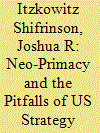

|
|
|
|
|
| Summary/Abstract |
Over the last half decade, a bipartisan consensus has emerged in US foreign policy circles calling for sustained competition with China. The ostensible goals of this competition are to protect the extant international order, block Chinese regional hegemony, and defend American allies—all of which notionally require major changes in US grand strategy.
|
|
|
|
|
|
|
|
|
|
|
|
|
|
|
|
| 9 |
ID:
179383


|
|
|
|
|
| Summary/Abstract |
Even before the 2020 China-India boundary crisis, there was some discussion about how India would approach intensifying Sino-US competition. In India, there has been a tendency to compare it to Delhi’s options during the Cold War, with many arguing that alliances are anathema and therefore India would and should remain non-aligned. Other possibilities put forth have included India as a swing state between China and the United States. Yet others—often outside India—suggest that Delhi will have to choose.1 Since the Sino-Indian boundary crisis broke out in May 2020, the discussion has turned to whether or not the skirmishes would, or should, lead India to “pick a side” in unfolding Sino-US competition.
|
|
|
|
|
|
|
|
|
|
|
|
|
|
|
|
| 10 |
ID:
179387


|
|
|
|
|
| Summary/Abstract |
If any of Donald Trump’s initiatives ought to outlast his presidency, the Indo-Pacific strategy is arguably the most deserving candidate. The recognition that the Indo-Pacific region should become the centerpiece of America’s global engagement obviously predated Trump. Former Secretary of State Hillary Clinton, for example, acknowledged in 2010 “how important the Indo-Pacific basin is to global trade and commerce.
|
|
|
|
|
|
|
|
|
|
|
|
|
|
|
|
|
|
|
|
|